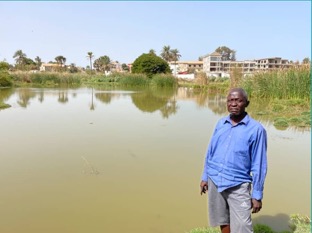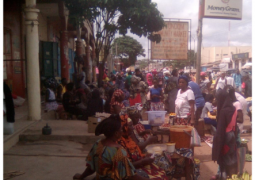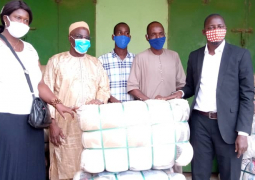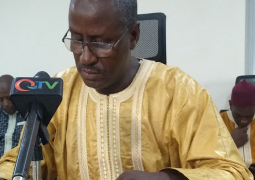
Their fields were ideal for rice cultivation until new structures began appearing on the opposite banks, pushing the water into his fields a few decades ago.
Anthropogenic activities such as construction works for residential expansions span across the stream severely constricting the waterway; creating clutters along the stream, and redirecting water movements, thus leading to an increased risk of flooding. In some places across the stream, physical structures have pushed the boundaries of the stream, exposing nearby families to the risk of fluvial flooding.
“I used to survive on these rice fields, but they are now inundated,” Mr Mendy said as he waved his arm in a semicircle, illustrating vastness of the fields that has to be their rice fields but now turned into uncultivable area. “All my rice fields have been destroyed due to the blockage of the water on the other side of the stream.”
These and other challenges faced by Mr Mendy and hundreds of thousands of others in 11 communities along the Kotu Stream are now targeted for World Bank interventions through the West Africa Coast Areas Management Programme (WACA). This project is currently being implemented in nine countries – The Gambia, Benin, Côte d’Ivoire, Ghana, Guinea-Bissau, Mauritania, Sao Tomé and Principe, Senegal, and Togo.
In The Gambia, the project was launched in 2023 for a duration of five years. It is to support the restoration and reprofiling of the 11.2 km Kotu Stream. According to the Ministry of Environment, Climate Change and Natural Resources (MECCNAR), this project is also expected to strengthen institutions and policies to enhance quality service delivery and build the resilience of the affected communities along the stream.
“The project holds huge potential – it is expected to protect more than 200,000 people living in communities along the Kotu Stream from the risk of flooding and pollution. It will completely restore and reprofile the Kotu Stream, build bridges across the Stream to facilitate accessibility, construct drainage systems to reduce flooding and support livelihood development. This will be achieved with a blend of nature-based solutions and innovations that protect the ecological integrity of the Stream,” said Muhammed Lamin Sanyang, WACA Gambia Project Coordinator at the Ministry.
The WACA Gambia Project, in collaboration with implementing partners, initiated short-term works on the Kotu Stream and adjoining drainage systems, with the objective of reducing the risk of flooding and pollution in communities during the rainy season.
Over the past two months, the project officials said more than a kilometre of drains around the Bakoteh Fish Market area were cleared in preparation for the rainy season.
“Initially, I was concerned that our market, particularly the canteens at the back, might experience flooding,” said Ms. Sainabou Phall, Bakoteh Fish Market Manager. “However, thanks to the recently cleaned gutters, these areas have remained flood-free. This has greatly enhanced accessibility, allowing people to shop with ease and ensuring that delivery trucks can reach the market without any issues.”
These interventions came following consultations with community leaders along the Kotu Stream, including ward councillors and the project implementing partners – Kanifing Municipal Council, Brikama Area Council, National Environment Agency, National Disaster Management Agency, and National Roads Authority.
Some of the measures include clearing of the entire stream of waste, removal of illegal dumpsites, of vegetation and grasses, and desalting several areas of the Stream to enhance water flow. Interventions also include the clearing of the main drains connected to the stream – with a combined length of over 3km– to facilitate storm water flow and reduce the risk of flooding, and procurement of floodwater pumps.
Project officials have confirmed the delivery of 34 floodwater pumps to high-risk communities in June this year, to the National Disaster Management Agency (NDMA) and local authorities in Kanifing and Brikama by the WACA Project.
According to the project’s policy brief, primary target area of intervention in The Gambia is a land area of 1,881 hectares stretching 11.2 kilometres from the West Coast Region settlement of Nema Kunku to Kotu on the Atlantic Ocean. An estimated population of 201,044 living along the Stream as of 2020, are targeted to benefit from its interventions.
“The Stream is part of the major flood flashpoints in the Greater Banjul Area and when restored, it has the potential to mitigate and prevent flooding in nearby communities and beyond,” the brief said.
If effectively implemented, the restoration of the stream will he fully realized as the project will propose hybrid, nature-based solutions to strengthen the resilience to flood risks, improve attractiveness and accessibility of the Kotu Stream, thus improving liveability and the urban environment, protecting the public health of communities.
When that happens, farmer families like Peter Mendy would have their livelihoods restored through sustainable development of communities living along the Kotu Stream, including urban farming initiatives and commercially sustainable, women-owned small-sized waste recycling initiatives.





